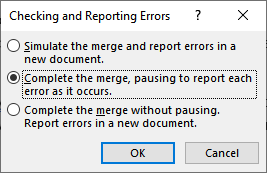Please Note: This article is written for users of the following Microsoft Word versions: 2007, 2010, 2013, 2016, 2019, 2021, and Word in Microsoft 365. If you are using an earlier version (Word 2003 or earlier), this tip may not work for you. For a version of this tip written specifically for earlier versions of Word, click here: Checking Your Data File.
Written by Allen Wyatt (last updated February 4, 2023)
This tip applies to Word 2007, 2010, 2013, 2016, 2019, 2021, and Word in Microsoft 365
Word includes a powerful feature called Mail Merge that allows you to combine a document with data from a data source to create individualized documents. Once you have created your main document and your data file is attached, it is a good idea to run a final check by comparing your data file with your document. To do this, start by opening your main document. Make sure the Mailings tab of the ribbon is displayed.
In the Preview Results group click the tool called Check for Errors or, in earlier versions of Word, called Auto Check for Errors. Word displays the Checking and Reporting Errors dialog box. (See Figure 1.)

Figure 1. The Checking and Reporting Errors dialog box.
Select the radio button that indicates how you want Word to check your data file. The selection you make depends on how confident you are in the quality of your data file. If you are fairly confident in its quality, accept the default and allow Word to show you the few errors your file may contain. If you aren't sure about the quality of your data file, then select the first option to simulate a merge and report the errors in a new document.
WordTips is your source for cost-effective Microsoft Word training. (Microsoft Word is the most popular word processing software in the world.) This tip (9739) applies to Microsoft Word 2007, 2010, 2013, 2016, 2019, 2021, and Word in Microsoft 365. You can find a version of this tip for the older menu interface of Word here: Checking Your Data File.

Learning Made Easy! Quickly teach yourself how to format, publish, and share your content using Word 2021 or Microsoft 365. With Step by Step, you set the pace, building and practicing the skills you need, just when you need them! Check out Microsoft Word Step by Step today!
If you are filtering a mail merge in Excel, and you get blank labels in the printout in Word, chances are good that ...
Discover MoreMail merge can be used to put together groups of documents that rely on common information. This tip shows how mail merge ...
Discover MoreWhen you use the mail-merge capabilities of Word, the information merged takes on the formatting of your source document, ...
Discover MoreFREE SERVICE: Get tips like this every week in WordTips, a free productivity newsletter. Enter your address and click "Subscribe."
There are currently no comments for this tip. (Be the first to leave your comment—just use the simple form above!)
Got a version of Word that uses the ribbon interface (Word 2007 or later)? This site is for you! If you use an earlier version of Word, visit our WordTips site focusing on the menu interface.
Visit the WordTips channel on YouTube
FREE SERVICE: Get tips like this every week in WordTips, a free productivity newsletter. Enter your address and click "Subscribe."
Copyright © 2025 Sharon Parq Associates, Inc.
Comments